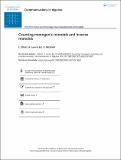Files in this item
Counting monogenic monoids and inverse monoids
Item metadata
| dc.contributor.author | Elliott, L. | |
| dc.contributor.author | Levine, A. | |
| dc.contributor.author | Mitchell, James David | |
| dc.date.accessioned | 2023-05-31T09:30:14Z | |
| dc.date.available | 2023-05-31T09:30:14Z | |
| dc.date.issued | 2023-11-01 | |
| dc.identifier | 286136026 | |
| dc.identifier | 3e5f2dd3-cb3a-402e-b06a-38b935661132 | |
| dc.identifier | 85161313740 | |
| dc.identifier.citation | Elliott , L , Levine , A & Mitchell , J D 2023 , ' Counting monogenic monoids and inverse monoids ' , Communications in Algebra , vol. 51 , no. 11 , pp. 4654-4661 . https://doi.org/10.1080/00927872.2023.2214821 | en |
| dc.identifier.issn | 0092-7872 | |
| dc.identifier.uri | https://hdl.handle.net/10023/27702 | |
| dc.description | Funding: The second and third authors would like to thank the London Mathematical Society, the Heilbronn Institute for Mathematical Research, and the University of St Andrews, for their support of this work. | en |
| dc.description.abstract | In this short note, we show that the number of monogenic submonoids of the full transformation monoid of degree n for n>0, equals the sum of the number of cyclic subgroups of the symmetric groups on 1 to n points. We also prove an analogous statement for monogenic subsemigroups of the finite full transformation monoids, as well as monogenic inverse submonoids and subsemigroups of the finite symmetric inverse monoids. | |
| dc.format.extent | 8 | |
| dc.format.extent | 1074166 | |
| dc.language.iso | eng | |
| dc.relation.ispartof | Communications in Algebra | en |
| dc.subject | Inverse semigroup | en |
| dc.subject | Monogenic semigroup | en |
| dc.subject | Transformation semigroup | en |
| dc.subject | QA Mathematics | en |
| dc.subject | T-NDAS | en |
| dc.subject | MCC | en |
| dc.subject.lcc | QA | en |
| dc.title | Counting monogenic monoids and inverse monoids | en |
| dc.type | Journal article | en |
| dc.contributor.institution | University of St Andrews. Pure Mathematics | en |
| dc.identifier.doi | https://doi.org/10.1080/00927872.2023.2214821 | |
| dc.description.status | Peer reviewed | en |
This item appears in the following Collection(s)
Items in the St Andrews Research Repository are protected by copyright, with all rights reserved, unless otherwise indicated.

